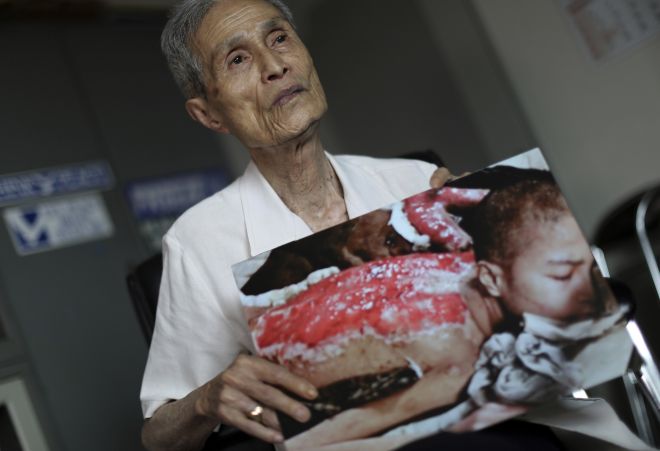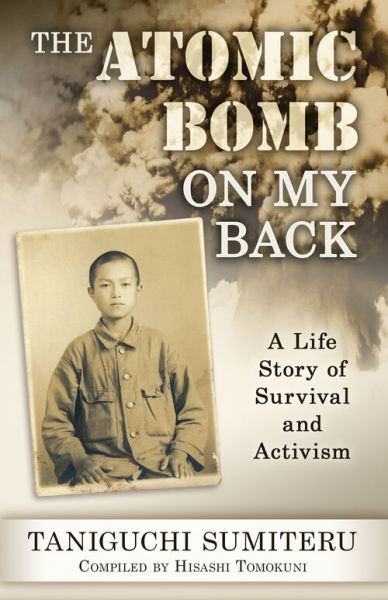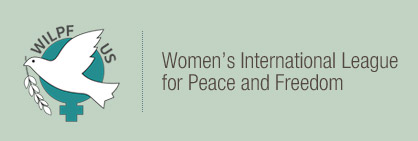Important Book to Read Now: Sumiteru Taniguchi’s "The Atomic Bomb on My Back"
Published on July, 29 2020
In this June 30, 2015 photo, Sumiteru Taniguchi, a survivor of the 1945 atomic bombing of Nagasaki, shows a photo of himself taken in 1945. Taniguchi devoted his life to seeking to abolish nuclear weapons after he was burned severely in the 1945 attack. (AP Photo/Eugene Hoshiko, file)
By Robin Lloyd
Co-chair, Disarm Committee
August 2020
Sumiteru Taniguchi’s The Atomic Bomb on my Back: A Life Story of Survival and Activism will be released on August 9, 2020 by Rootstock Publishing. This is an important book to read as we approach the 75th anniversary of the dropping of nuclear bombs on the cities of Hiroshima and Nagasaki. This book tells the back story of a hibakusha – the Japanese word for atomic survivor. When I say ‘back story’ I mean this literally, since it was Sumiteru Taniguchi’s back that bore the fury of the heat assault from the Nagasaki bomb. It became even more of a 'back story' when a young American photographer took his picture lying on his stomach on a gurney with his back crimson with the skin burned off. It took time for the photo to 'go viral’, but when it did, Taniguchi hesitantly became the poster boy for the hibakusha movement.
Most testimonies that I have heard from survivors speaking at peace conferences describe the agony of their encounter with the bomb, and the years of suffering that followed, but few enter into the politics and rage that motivated their movement. Taniguchi describes the primal anger he felt that something so monstrous had been developed and experimented on him and the Japanese people. He also voices deep disappointment that his government did not acknowledge their suffering.
He explains that hibakusha organizations petitioned and rallied and pleaded with the Japanese government to provide compensation to the victims. One problem was that in the postwar settlement between the US and Japan, the Japanese government had waived its claims for compensation from the US.
Over time, the bomb was seen as an illegal weapon and thus relief measures could be sought in the courts. But the Japanese government could claim ‘we didn’t drop the bombs, why should we pay damages to you?’ Finally a Tokyo District Count ruling acknowledged the illegality of the A bombings as well as the Japanese government’s responsibility for the war.
Taniguchi spoke at many peace conferences during his lifetime of activism. I travelled to Japan in a peace delegation to attend the 40th anniversary of the A and H bomb conference of 1985. There I learned that the whole nuclear fuel cycle spreads devastation at every point: among the indigenous people who are hired to mine uranium, to the people in assembly plants, to the military overseeing the testing, and finally to the Pacific Islanders who have endured the explosions on their islands.
This testimony by Taniguchi gives a clearheaded but passionate account of the struggle maintained by the hibakusha, individually and in their organizations, insisting that their concerns be heard by the public. He ends, “I will continue to speak out for the elimination of nuclear weapons with all the strength of life left in me.” Though he died of cancer in 2017, he did speak out until the end of his days, and this book continues to enable his words to be heard even though he is no longer with us.
Now that this book is translated into English, with a powerful introduction by Peter Kuznick, I hope his message will spread to a new and receptive audience.
 WILPFers and friends WILPFers and friends By ordering directly from the publisher, you can get a 20% reduction in price by writing in the code WILPF20. Rootstock Publishing, 27 Main Street, Suite 6, Montpelier VT 05602 USA www.rootstockpublishing.com 802-839-0371. |



